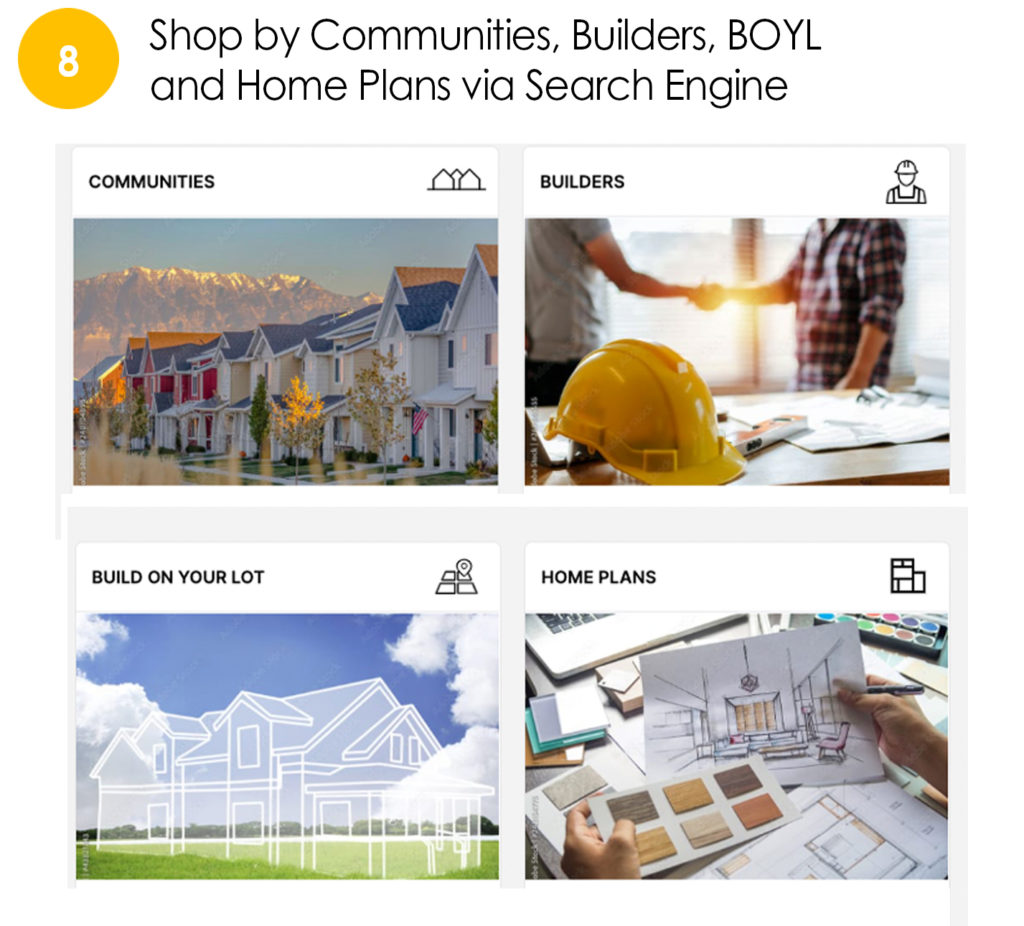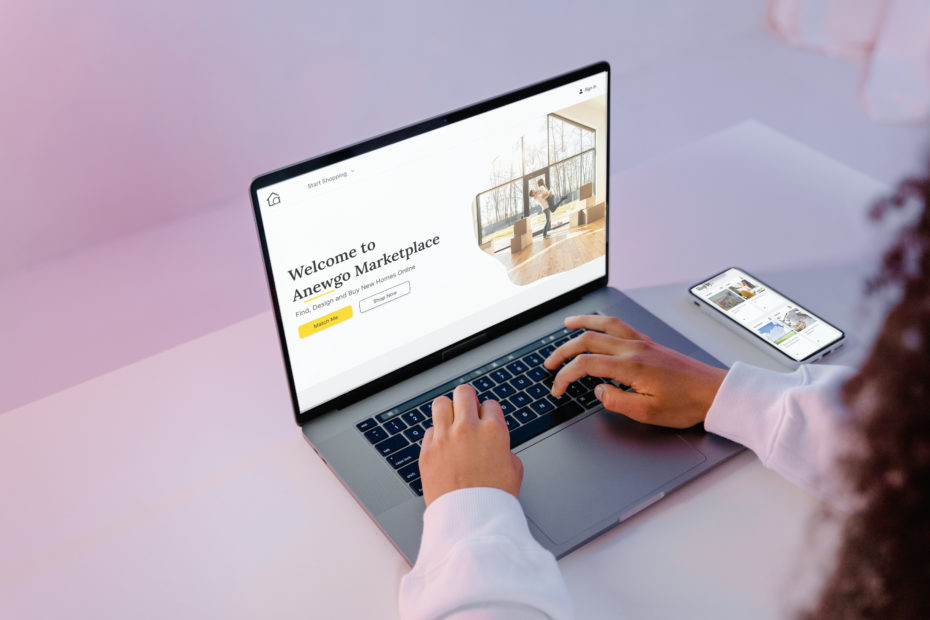With the launch of Anewgo Marketplace (AMP) on 9/20, we break down 10 key features that will change the way that new home buyers will shop and buy new homes forever. From collaboration to smart filters to match and notify, Anewgo Marketplace (AMP) offer the most advanced customer journey of any new (or pre-existing) home shopping marketplace.

Unlike static, generic websites where it’s the same thing for everyone, everyday, AMP is a web app website that dynamically changes around each customer’s unique interests; providing a personalized shopping experience. Web pages and content are auto-generated around each shopper’s behavior – like Facebook and Amazon. Unlike native apps, our web app does not require downloading and is viewable across all devices and browsers.
It also utilizes Headless CMS technology. So unlike traditional Content Management Systems, the Presentation UI layer (the head) is separated from the CMS (the body). This enables the content to be updated once, but it immediately proliferates across other channels, formatted to each channel’s unique interfaces. All of the content and data is cloud-synced.
This Headless CMS technology will be evident in the next stage of AMP in our Why New? section where visitors can learn and explore New Construction across a myriad of marketing channels. They can even “play house” where both average consumers and experts can collaboratively design, experience and share their dream homes online.

The complex and extensive New Home online shopping journey takes buyers across multiple marketing channels such as: websites, email, social, sales centers and now, the marketplace portal. Like Netflix, our Omnichannel Cloud-synced Ecosystem, with custom UIs for each channel, enables buyers to start and resume wherever they left-off in their personal, any order, sales funnel. No more siloed, start-over experiences. This technology enables synced-personalized content across indeterminate omnichannel shopping journeys.
Our Insights Analytics tracks each registered buyer’s unique cross-channel shopping journey – visually-displaying their favorite communities, homesites and custom-designed floorplans and exterior colors. Insights also shows the personalized brochures that each shopper has downloaded, emailed or shared on social.


Unlike Floorplans where shoppers have to scour endless floorplans to find specific rooms (if they even exist) – with our AI Text Recognition technology (which reads the text on floorplans, tags them and adds to our library), buyers can simply select the rooms they want from a smart filter list. It’s smart because it displays how many plans have that feature. As selections are made, the counts and the plan gallery immediately update via our visual search engine. Since room names vary by locale, our thesaurus also filters across a synonym of terms.
Personal filters can be saved to the buyer’s preferences for future shopping. Like Pinterest, the filter selections appear as tags across the top for easy reference and modifications. The tags also appear in community and plan descriptions.
Best of all, the automated tagging doesn’t require builder input! For buyers and sellers alike, this is a quick way to find the communities and plans they are looking for – so buyers can start designing their custom homes with our interactive floorplans, exterior color, and interior design tools.

For Marketing, Salespeople, Agents and even Buyers, social sharing is a fun and engaging way to drive traffic, engagement, followings and collaboration. That’s why we’ve added SHARE buttons that enable these users to quickly share their communities, plans and even designs to different audiences via Facebook, Twitter, LinkedIn and Email campaigns.
The general or specific content is conveniently auto-written with backlinks to respective web pages and auto-formatted for each unique channel. When recipients click the embedded links, they can view the content. Unregistered users are prompted to register to filter for their perfect homes and collaboratively design and save their custom homes online.
This engagement not only creates free viral marketing, but it also provides valuable analytics that show contact information, click-thrus, sharing platforms and shopping behavior. Seamlessly tying shopping to social and back to shopping effectively utilizes social commerce to drive buyers down personal online sales funnels.

Builders don’t just sell houses, they also sell the location. Our UI enables shoppers to quickly find the perfect spot.
For community searches, buyers can type in a zip code, county or city. But like other portals, they can simply draw a circle around the interested area on the map. Check “Show Counties” to display county lines.
Once a community is selected, a list of nearby schools with ratings and the distance from community appears. Using a Points of Interest Google map, buyers can see their specified interests within a desired radius range and also get directions.
Our AI suggests nearby communities from closest proximity to the current one. If a home plan is selected, it suggests available inventory homes of that plan as well as other communities where that plan is available.
For Build on Your Land searches, to see what builders build in a specific county, simply click on that county on the map. Ultimately, we will incorporate landowners to match buyers with builders and land sellers.

Finding the perfect home entails matching ideal homesites and house plans. Shoppers need to visually compare them side-by-side and the AI needs to automatically show which combinations are possible.
As shoppers can be lot-centric or plan-centric, they can use a sliding divider to enlarge the focal area starting point. Responsive design adjusts the layouts accordingly.
Lot-centric: 1) Select the homesite that you want from the interactive site plan to display all of the plans that can be built on your lot. 2) Use the Plan Filters button, to only see the plans that have the # of stories, floorplan features, exterior facade (stone, brick, etc.) and house style that you want. 3) Select your favorite house to custom design it.
Plan-centric: 1) Start with the Plan filter to find which house you want. 2) On site plan choose that desired plan from the drop down list to show which lots have that plan. You can refine your homesite search by filtering lot size, premiums and status (available, inventory, etc.) and even the construction stage. 3) Select your desired lot to custom design your home.
If it’s a Master Plan development with multiple phases, each phase is highlighted on the site plan. Simply click on that phase to drill down to the lot selection features.
The combination of visualization, AI, text recognition and search engine technologies make this painfully complex task as easy as 1-2-3 online!

Buyer’s portals (or shopping carts) are critical to transitioning from simply marketing online to shopping and buying new homes online. AMP’s private buyer’s portals enables shoppers to take their virtual shopping cart across our omnichannel network (marketplace, builder’s website, sales centers) in any shopping order – starting where they left-off and finishing anywhere.
The portal contains the buyer’s and co-buyer’s contact information and all of their favorited communities, builders and custom-designed homes. It also stores their shopping preferences and our AI-recommendations for their desired communities and plans. The UI is designed for shopping online.
Similarly, Agents and Builders will have their own unique portals with UIs designed around co-shopping and selling. They are connected to each opted-in Buyer’s portal data – similar to patient/doctor/insurance/hospital health portals. Connected to facilitate tasks, yet respects buyer privacy.
These portals will enable the different parties to collaborate and seamlessly move the buyer down online marketing AND sales funnels. Instead of a system of costly, cumbersome, lengthy marketing to sales hand-offs, everything happens in real-time in an end-to-end e-commerce ecosystem.

Buying a new home is a very complex, comparative and collaborative process. Doing this online with all necessary parties requires the aforementioned technologies. Our software also enables shoppers to compare their favorite builders, communities and custom-designed favorite plans, in detail, side-by-side.
Then, for collaborative shopping and design online, buyers can share their favorites with friends and family. Buyers can give their collaborators “view” or “view and edit” rights for each favorite. With “edit” rights, house design revisions (even colors) by any collaborators are instantly updated and seen by all. If someone is shared a home with only “view” rights, she can duplicate it and make her own changes without changing the original. She can then share back her own design to her collaborator group. All shares are time-stamped with the collaborator’s name.
For Conversational Marketing, collaborators can use star ratings to convey their rankings of favorites to compare with others’ ratings. Soon, collaborators can explain their ratings with Direct Messaging, which also retains the communication threads for each favorite. Filtering, sorting and soon, grouping of Favorites, help facilitate the collaborative shopping process.
Once the collaborative shopping is done, buyers can download, or email pdf brochures and links to their favorite designs to the builder.
These features can also be initiated by Agents, Marketing and Sales to recommend and assist in the online shopping process.

Finding a new home is like looking for a needle in hundreds of website haystacks. It begins with using a search engine to just identify endless, disparate builder websites to then start arduously searching each haystack – not knowing if your needle is even in any of them. Builders are probably losing more leads to the process than to their competition.
Instead of going to different websites, we’ve brought all of the products from our builders’ websites into a Marketplace to provide “Match and Notify”. After completing a short quiz of “must have” and “desired” features for your community, house and lifestyle, our AI instantly recommends communities and plans in order of the closest locations and best-matched attributes. No more repeatedly searching ever-changing website content and product availabilities, just hit “Match Me”, or set daily or weekly notifications and AMP brings the products to you.
This convenience feature reduces frustration, the risk of missing something, and precious time. Eventually, buyer’s designated co-buyers can also be notified of recommendations. Of course, shoppers can still manually search within our omnichannel ecosystem as well and then design, compare, save and share their favorites.
Like ride-sharing and dating sites, matching will become the primary search method because shoppers can just set it and forget it. Why repeatedly spend hours at a time searching just a few websites with changing products when you can be notified of your dream home matches as they become available across thousands of builders, communities, plans, options and homesites in seconds? Manual searches will become the back-up method. Even for salespeople and agents.
After all, notifications are like daily sales calls – but with excitement, not annoyance. Better than relying on shoppers to come looking daily – especially if they are notified by other builders.


Internet search engines only give shoppers a list of builder website “stores” to then start manually searching each store’s different aisles, one-by-one. Our Marketplace search engine applies search to all of the stores’ products – like Amazon. It brings desired communities, plans, homesites and options from hundreds of builders to each unique buyer. AMP searches are not high-level, generic web pages, but specific products.
Instead of traversing fixed website paths with set presentation orders, buyers can start shopping the way they want. By:
1. Communities
2. Builders
3. Build On Your Land
4. Home Plans
Buyers can search by the usual Location, BR, BA, SF and Price. But they can also search by Architectural Styles, Builder Types and Specialties, Exterior Facades, Standard and Optional Rooms, Community Features and Amenities, and Points of Interests.